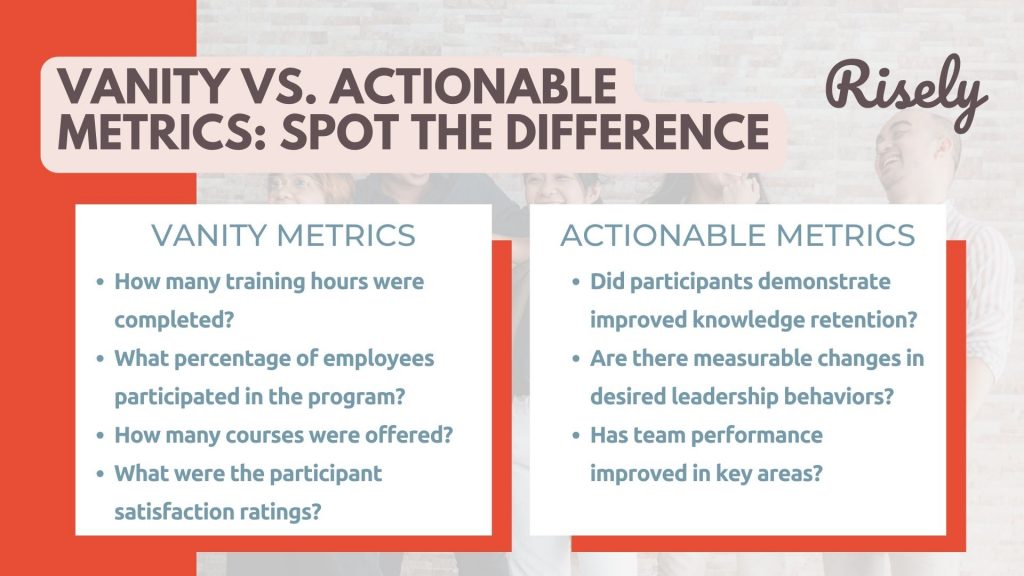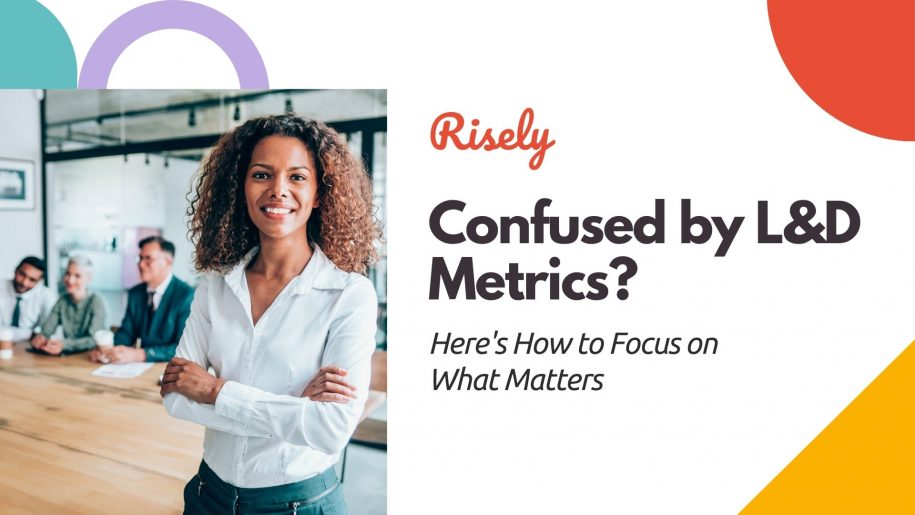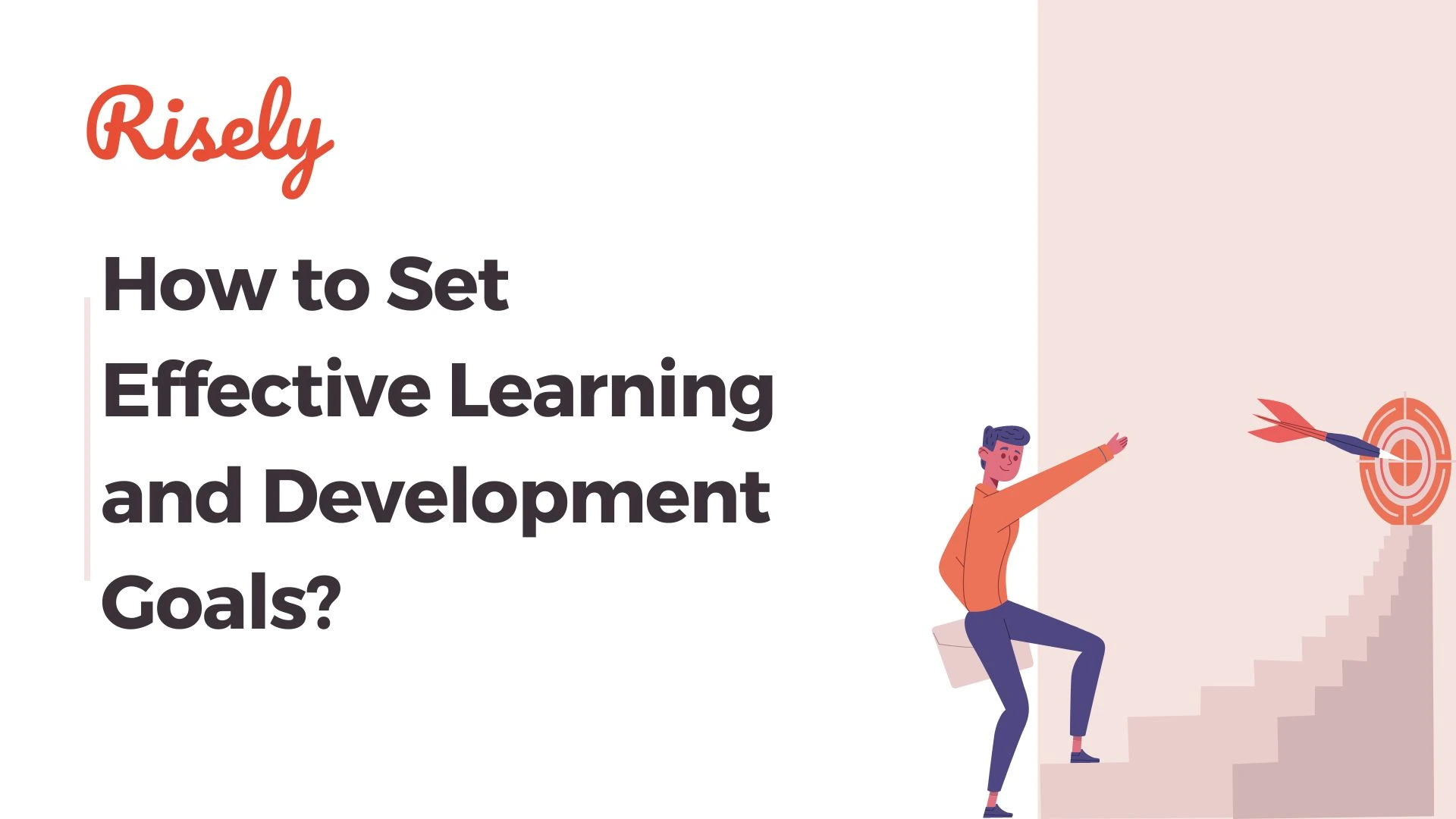Confused by L&D Metrics? Here’s How to Focus on What Matters
You’ve undoubtedly witnessed companies celebrating a record number of employees completing leadership training programs. Champagne toasts erupt, press releases tout the accomplishment, and everyone feels a sense of accomplishment. But fast forward a year, and the celebratory mood sours. Managers express disappointment as the promised improvements in team performance and employee engagement fail to materialize. New skills aren’t being applied, and frustration mounts. This scenario exemplifies a widespread pitfall in L&D: overemphasizing vanity metrics. Metrics like course completion rates provide a feel-good narrative but fail to capture the true impact of training programs. They paint a surface-level picture, neglecting the all-important question: did the training translate into tangible results? This is where a deeper understanding of L&D metrics becomes crucial. If you have been in a similar situation, keep reading to see how to avoid it.Table of Contents
- Confused by L&D Metrics? Here’s How to Focus on What Matters
Definition and Significance of L&D Metrics
Measuring the effectiveness of training programs goes beyond simply counting participants or completion rates, which form the part of learning analytics. This is where L&D metrics come into play. They act as a compass, guiding us to understand how learning initiatives translate into tangible results. L&D metrics encompass a comprehensive set of data points that assess the impact of ongoing training programs on various aspects. By leveraging L&D metrics, organizations gain valuable insights that empower them to:- Evaluate the effectiveness of training programs: Metrics provide a data-driven approach to assess whether the training is meeting its intended objectives.
- Identify areas for improvement: Analyzing data helps pinpoint weaknesses in the program’s design, delivery, or content, allowing for targeted adjustments.
- Optimize resource allocation: Metrics ensure that resources are invested in programs that demonstrably yield positive results.
- Demonstrate the return on investment (ROI) of L&D initiatives: Data enables organizations to quantify the tangible benefits of training programs, justifying their continued investment.
Why Real Metrics Matter More Than Vanity Metrics?
While these metrics offer valuable insights on your workplace’s learning and development, it’s crucial to differentiate between actionable and vanity metrics. Vanity metrics present a superficial picture of training activity, often focusing on surface-level achievements that don’t necessarily translate to actual skill development or improved performance. Here are some commonly used vanity metrics in L&D:- Number of training hours completed: While attending training sessions is essential, focusing solely on the duration doesn’t guarantee knowledge retention or application.
- Course completion rates: High completion rates might indicate program accessibility but don’t reveal how much participants learned or how effectively they can apply the acquired knowledge.
- Participant satisfaction scores: Positive feedback about the training experience is valuable but doesn’t necessarily reflect whether participants gained the necessary skills or are implementing them in their work.
Other Interesting Reads
Focusing on Actionable Metrics
While vanity metrics might offer a comforting illusion of progress, true organizational growth necessitates a shift toward actionable metrics. These metrics act as a bridge, directly linking learning activities to real business outcomes. They move beyond simply measuring training completion and delve into the heart of the matter: did the training translate into tangible results?Why Actionable Metrics Matter?
Focusing solely on vanity metrics creates a misleading narrative. High completion rates and positive satisfaction scores paint an incomplete picture, neglecting the crucial question: are employees applying the acquired knowledge and skills in their daily work? Actionable metrics address this gap by measuring the following:- Changes in behavior: Do leaders exhibit the desired behaviors learned during the program, such as improved communication, delegation, or problem-solving skills?
- Skill application: Are participants actively utilizing the learned skills in real-world work situations?
- Team performance: Do teams led by trained individuals demonstrate measurable productivity, efficiency, or improvement in goal achievement?
Examples of Actionable Metrics:
Actionable metrics provide a comprehensive picture of the program’s influence, encompassing various aspects:- Increased Employee Engagement: Does the training lead to a more motivated and engaged workforce, fostering a positive work environment and a stronger sense of ownership?
- Improved Productivity and Performance: Do trained employees demonstrate a measurable increase in output, efficiency, or the ability to achieve set goals?
- Reduced Turnover Rates: Does the training contribute to a more satisfied and committed workforce, leading to lower employee turnover rates?
- Positive Impact on Customer Satisfaction: Does the training equip employees with the skills and knowledge to deliver exceptional customer service, leading to higher customer satisfaction scores?
- Enhanced employee capabilities: Employees gain the necessary skills and knowledge to excel in their roles.
- Improved team dynamics: Teams function more cohesively and efficiently, achieving goals collaboratively.
- Stronger customer relationships: Employees are better equipped to deliver exceptional customer service, fostering loyalty and satisfaction.
- Achieving strategic objectives: The training program directly supports the organization’s strategic goals, driving sustainable growth and success.

Navigating Challenges in L&D Metrics: Moving from Vanity to Actionable Measures
While the shift towards actionable metrics offers a plethora of benefits, the journey isn’t without its roadblocks. Here, we explore some common challenges organizations face in transitioning from vanity metrics to a more impactful measurement approach:- Quantity over Quality: Traditional metrics often focus on the volume of training delivered (e.g., number of training hours, courses completed). This approach prioritizes completion over learning outcomes. Solution: Move beyond simply counting hours. Focus on assessing knowledge retention, skill application, and behavioral changes in participants.
- Misalignment with Business Goals: Vanity metrics might not directly connect to the organization’s strategic objectives. This creates a disconnect between training efforts and desired business outcomes. Solution: Ensure L&D initiatives are aligned with the organization’s strategic goals. Design training programs that address specific skills and behaviors required to achieve those goals.
- Inability to Measure Impact: Vanity metrics often fail to capture the true impact of training on crucial aspects like employee performance, employee engagement, and retention rates. Solution: Integrate metrics that assess these behavioral changes and business outcomes.
- Limited Actionability: Vanity metrics often provide limited insights for actionable improvements. They tell you what happened (e.g., training completion) but not how it impacted the organization. Solution: Focus on metrics that provide clear direction for improvement. Analyze data to identify areas where the program might be falling short and use those insights to refine the training content, delivery methods, or assessment strategies.
- Resistance to Change: Shifting from a culture of vanity metrics to a data-driven approach might encounter resistance from stakeholders accustomed to traditional measurement methods. Solution: Foster a culture of continuous improvement and data-driven decision-making. Showcase the benefits of actionable metrics in demonstrating the tangible value of L&D programs.
- Leadership buy-in: Secure the active involvement of senior leaders in advocating for the importance of measuring the impact of L&D initiatives.
- Collaboration: Establish clear communication channels between L&D professionals, HR, and business leaders to ensure alignment between training programs and organizational goals.
- Data collection and analysis: Invest in robust systems for collecting and analyzing data relevant to actionable metrics.
- Continuous evaluation: Regularly review and refine L&D programs based on the insights gleaned from data analysis.
How Risely Bridges the Gap with Actionable Metrics?
Having established the challenges and importance of transitioning from vanity metrics to actionable L&D metrics, let’s delve into how Risely’s features bridge this gap and empower organizations to measure the true impact of their leadership development initiatives. Risely’s Features:- Daily Nudges: These targeted micro-learning opportunities go beyond traditional training modules. Daily nudges reinforce key concepts, promote knowledge retention, and provide opportunities for applying learned skills in real time. This continuous reinforcement fosters behavioral change, a crucial aspect of measuring actionable metrics.
- Skill Center: This comprehensive library provides leaders with on-demand access to resources and tools aligned with their development needs. By tracking skill usage and engagement within the Skill Center, Risely offers insights into Knowledge acquisition and Skill application.
- Changes in behavior: Daily nudges and the Skill Center’s practical resources encourage consistent application of learned skills, leading to observable behavioral changes in leaders.
- Improved team performance: By equipping leaders with the necessary skills and fostering a culture of continuous learning, Risely indirectly contributes to improved team performance metrics like productivity, efficiency, and goal achievement.
Conclusion
While traditional L&D metrics might provide a superficial sense of accomplishment, true organizational growth necessitates a shift towards actionable metrics. These L&D metrics bridge the gap between training activities and tangible business outcomes, ensuring that your investment in leadership development yields measurable results. Risely empowers you to move beyond vanity metrics. Our features and AI coach, Merlin, provide a comprehensive approach to measuring the true impact of your L&D programs. Don’t let vanity metrics hold you back. Sign Up on Risely today.Build a goal-oriented L&D strategy with Risely’s free template!
Grab free resources like L&D strategy framework and start making big moves with your team.
Other Related Blogs
How to Set Effective Learning and Development Goals?
This blog highlights how effective learning and development goals are set, why is setting them important for your organization and what challenges you might face during this process. … Read…
Are you on track to meet your Q1 goals?
Are you on track to meet your Q1 goals? We are in the middle of the first quarter of 2024. Seems hard to believe. It surely is! ⏰ Time has…
5 Secrets Of Solid Goal Setting At Work You Can’t Miss
5 Secrets Of Solid Goal Setting At Work You Can’t Miss “I don’t focus on what I’m up against. I focus on my goals and I try to ignore the…
Understanding the world of Goal Setting Coach to reach new heights
Understanding the world of Goal Setting Coach to reach new heights Setting and achieving goals is essential for personal and organizational success in today’s fast-paced and competitive work environment. However,…


